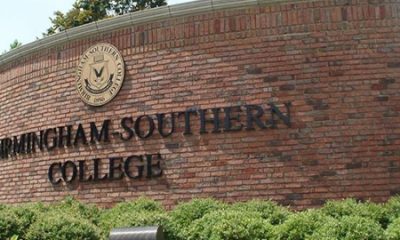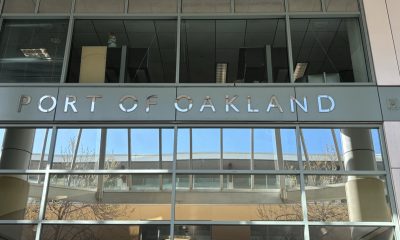Environment
Oakland’s Superintendent Guarantees Clean Drinking Water at McClymonds High School

Left to right: Star, a student, parent volunteer Tolani King and John, an Alhambra Water employee, stand next to a new water dispenser that was installed last Friday in the hallway at McClymonds High School. Photo by Ken Epstein.
Though tests found lead in the drinking water at several spots at McClymonds High School in West Oakland, the Oakland Unified School District did little to respond during the last year of the administration of Supt. Antwan Wilson, who left the district early in 2017.
The tests, conducted in August 2016 at the 100-year-old school, found unsafe levels of lead in three places on the campus, including in the showers in the boys’ and girls’ gym. As a result, the district closed the showers, which means the students have not been able to dress for gym for the past year.
But when Ben “Coach” Tapscott, a former Mack teacher and long an advocate for the school, raised an outcry last month, the district responded. He went to the Oakland Post, which published an article about lead in the water in drinking fountains on McClymonds football field. He also went to new district Supt. Kyla Johnson-Trammell, only on the job since July, who took action as soon as she became aware of the situation.
“I immediately called the superintendent’s office and told her that this has been going on for a whole a year,” he said. “She told me, ‘Coach, it will be fixed.´”
In the past few weeks, the district has made a number of immediate but mostly temporary fixes to make sure that students have a plentiful supply of clean water, free of toxic lead and sediments, which –though safe – discolor and cloud the water.
Water faucets by the bleacher area of the football field, which had tested positive for lead, have been fixed. The district replaced the faucets, installed a water filter and ran a new pipe out to the street.
Lead was also found in water faucets in the cafeteria, which have been replaced, and water filters have been installed to reduce the sediment, according to the district. The showers in the gym – the third place lead was found – are still closed, but new showerheads have been ordered to replace the old ones, which were discovered to be the source of the lead, according to the district.
Water in the main school building was found to be lead free but discolored by sediment. All the water faucets have been shut off and covered with plastic. The district contracted with Alhambra Water to place and supply water dispensers on all three floors of the school.
Coach Tapscott said he discovered the water problem when he went to watch Mack´s football team practice before school started.
“(Coach Mike Peters) told me water out there was not safe, and it contained lead. He said he had been going to his mother’s house for a year to fill up water containers, running up her water bill, to make sure the players had safe water.”
Coach Tapscott is outraged that district staff who were responsible for health and safety at the schools allowed students to drink contaminated water for at least a year, and he is determined that the district repair McClymonds to the standards of other schools, not to settle for stop-gap measures.
“Kids have been drinking that water for (at least a year) while people in this district sat on their butts and did nothing for the children,” he said. “Whoever is responsible for this should be fired.”
“They wouldn’t do this in a white school,” Tapscott added.
Tapscott said the district should replace its old galvanized pipes immediately. That would mean hiring a contractor and working weekends to put in new pipes inside and outside of the building.
“You can begin having water in three weeks, digging trenches and crews replacing all the pipes,” he said. “The main building is a challenge because kids are there, and the crews would have to work on weekends.”
According to the district, replacing the piping throughout the campus is now in the planning stages. The district estimates that the project will cost about $2.3 million and take a year or more to complete.
In a press statement, Supt. Johnson-Trammell pledged to the community that the district would do what is necessary to fix McClymonds.
“We will keep you, our students, staff, families and other stakeholders, apprised of the process. We will also be engaging the community to ensure that your voices help us determine the best, fastest and most cost effective way to complete these changes for the school.”
Activism
Oakland’s ‘Green the Church,’ Others, Host a Climate Revival
On April 20, Oakland’s Green The Church California (GTC) and the Center For Food, Faith and Justice will celebrate Earth Day and present a Climate Revival event titled “Growing Healthy Communities From Soil To The Soul” at McGee Avenue Baptist Church at 1640 Stuart St, Berkeley, CA. The day will include inspiring talks, interactive workshops, networking opportunities, and a special panel on Food Sovereignty and Global Food Resilience.

Growing Healthy Communities from Soil to the Soul in Berkeley
By Y’Anad Burrell
On April 20, Oakland’s Green The Church California (GTC) and the Center For Food, Faith and Justice will celebrate Earth Day and present a Climate Revival event titled “Growing Healthy Communities From Soil To The Soul” at McGee Avenue Baptist Church at 1640 Stuart St, Berkeley, CA,
The day will include inspiring talks, interactive workshops, networking opportunities, and a special panel on Food Sovereignty and Global Food Resilience.
The keynote speaker is Rev. Danté R. Quick, PhD, senior pastor of First Baptist Church of Lincoln Gardens in Somerset, N.J. Quick is well known in the Bay Area, having served for more than 10 years as pastor of Friendship Missionary Baptist Church in Vallejo, CA.
Green The Church, founded in 2010 by Rev. Dr. Ambrose Carroll, Sr., and headquartered in Oakland, helps galvanize Black churches and their local communities and leaders to address issues critical to populations historically disengaged from conversations around pollution and health, climate change, and sustainability and energy efficiency.
The organization collaborates with major environmental, sustainability, food security, faith, and community-based non-profit organizations, and is committed to “creation justice”—care and justice for God’s people and the planet—and building the Beloved Community.
Environmental justice has long been a pressing concern for communities of color who bear the brunt of pollution and ecological degradation. Climate change exacerbates these issues, disproportionately impacting vulnerable communities. Recognizing this urgency, Black churches across the country are taking action.
With deep roots in the African American community and its commitment to social justice, the Black Church has become an essential advocate for sustainable practices and policies.
Over the past 14 years, in a powerful collaboration with significant environmental, sustainability, food security, faith, and community-based non-profit organizations, GTC has created a cadre of Black churches engaging in the environmental justice, climate, and sustainability movement.
GTC presently works with more than 1,000 pastors and congregations across the U.S., and groups in the Bahamas, Ghana, Nigeria, and the UK, showing that we can make a difference together.
The partnership between environmental justice advocates and the Black Church extends beyond individual congregations. Green The Church provides resources and support for faith communities seeking to address climate change and promote environmental justice.
Through collaboration, initiatives such as energy efficiency programs, solar installations, and environmental education have been implemented in Black churches nationwide. These efforts reduce the carbon footprint and save money on energy bills, benefiting the congregations and their communities.
The involvement of the Black Church in the fight against climate change is not just a participation, it’s a powerful message that galvanizes action across communities.
By integrating environmental justice into their ministry, Black churches are demonstrating that addressing climate change is not only a matter of science but also of social and moral responsibility, inspiring change at a grassroots level.
For more information, go to: www.greenthechurch.org.
Bay Area
Richmond’s Growing Bay Trail Boasts Bountiful Beauty
The Standard recently enjoyed a sunny-day stroll through Richmond’s Barbara and Jay Vincent Park and an exquisite section of the city’s ample share of San Francisco Bay Trail. Near Vincent Park’s entrance, the Bay Trail offers locals a front-row view of Richmond’s Marina, with an eclectic mix of boats and some of the city’s shoreline eateries like Lara’s Fine Dining and Anh Restaurant & Bar.

By Kathy Chouteau
The Richmond Standard
When was the last time you used the Bay Trail in Richmond?
The Standard recently enjoyed a sunny-day stroll through Richmond’s Barbara and Jay Vincent Park and an exquisite section of the city’s ample share of San Francisco Bay Trail.
Near Vincent Park’s entrance, the Bay Trail offers locals a front-row view of Richmond’s Marina, with an eclectic mix of boats and some of the city’s shoreline eateries like Lara’s Fine Dining and Anh Restaurant & Bar.
Stroll further into the park on the trail and you’ll spy the Craneway Pavilion and Rosie the Riveter Park’s Visitor Center across the water, as well as ample geese—and if your timing is right—a few sailboarders getting ready to launch into San Francisco Bay.
A great kids’ playground and BBQ grills also await in the well-used park. Follow the trail around the western bend to see the park’s small but picturesque beach and clear-day views of San Francisco, the Golden Gate Bridge and more. The Bay Trail will lead you to Berkeley and beyond if you’ve got the energy.
To this reporter, who has spent lots of time here, Vincent Park and the Bay Trail are some of Richmond’s most stunning outdoor gifts for its people.
‘Gifts’ because our outdoor views don’t cost a thing yet deliver a quiet joy ready to reenergize you for the week. And for your kids and four-legged friends, there’s a world of sea creatures, shells, and other outdoor ephemera to discover after a dig in the sand.
Take it from someone who originally hails from a land-enclosed state, and a city where the most interesting hyper-local views were of the Bethlehem Steel mill in Bethlehem, Pa.
While my native city’s steel might have been used to build the Golden Gate Bridge and WWII ships, and this reporter has deep love for her hometown, trust me when I say that people in ‘the Rich’ are privy to some of the best views I’ve ever seen in our country.
According to the Trails for Richmond Action Committee (TRAC), Richmond has more than 32 miles of shoreline, which is more than any other city on San Francisco and San Pablo Bays. The Bay Trail currently has more than 300 miles completed of 500 planned for the trail around both bays. Enjoy Richmond’s bounty!
Want to learn more about the Bay Trail in Richmond? Check out TRAC.
California Black Media
After Severe Storms Kill 12, State Warns of Ongoing Dangers
State authorities and elected officials around California are thanking 8,500 first responders for their combined efforts over the past weeks to save lives during severe storms that killed 12 people, contributed to intense flooding, led to power outages, downed trees and caused more than $10 million in damages.

By California Black Media
State authorities and elected officials around California are thanking 8,500 first responders for their combined efforts over the past weeks to save lives during severe storms that killed 12 people, contributed to intense flooding, led to power outages, downed trees and caused more than $10 million in damages.
They are also directing Californians to resources to address losses they may have suffered during the storms and warning them of ongoing dangers.
“We mobilized an all-of-government response, including our swift water rescue teams that have made 47 rescues,” said Gov. Gavin Newsom. “We’re grateful to our thousands of first responders who have saved countless lives and kept our state going in the face of record-breaking rainfall and snow.”
On Feb. 4, the Governor declared a state of emergency in eight counties: Los Angeles, Ventura, Orange, San Bernardino, San Luis Obispo, Santa Barbara, Riverside and San Diego.
On Feb. 7, Newsom followed up by requesting a major disaster declaration from the White House to support San Diego County as it recovers from the storms.
“The late January storm saw record-breaking rain in San Diego, where the worst impacts were felt in lower-income neighborhoods. Many folks saw damage to their life’s work that can’t be recovered without federal support,” the Governor said.
On Feb 10, the Governor’s Office for Emergency Services (CalOES) provided safety tips for returning home aimed at Californians who had to evacuate, including how to deal with accumulated muck, mud and debris.
In Sacramento County, a 63-year-old woman was found dead under a large fallen tree in her backyard.
Effects of recent storms can weaken trees, leading to falling branches or even entire trees, which can cause damage to homes, and vehicles and pose a threat to public safety, according to Cal OES.
The sudden occurrence of toppled trees, fallen branches or uprooted trees saturated by standing water creates hazardous conditions for pedestrians, motorists, power lines and homes.
CalOES is urging Californians to stay informed about whether forecasts, and informed the public that it is still assessing storm damages.
-

 Activism4 weeks ago
Activism4 weeks agoOakland Post: Week of March 20 – 26, 2024
-

 #NNPA BlackPress3 weeks ago
#NNPA BlackPress3 weeks agoCOMMENTARY: D.C. Crime Bill Fails to Address Root Causes of Violence and Incarceration
-

 #NNPA BlackPress3 weeks ago
#NNPA BlackPress3 weeks agoMayor, City Council President React to May 31 Closing of Birmingham-Southern College
-

 #NNPA BlackPress3 weeks ago
#NNPA BlackPress3 weeks agoCOMMENTARY: Lady Day and The Lights!
-

 #NNPA BlackPress3 weeks ago
#NNPA BlackPress3 weeks agoFrom Raids to Revelations: The Dark Turn in Sean ‘Diddy’ Combs’ Saga
-

 #NNPA BlackPress3 weeks ago
#NNPA BlackPress3 weeks agoBaltimore Key Bridge Catastrophe: A City’s Heartbreak and a Nation’s Alarm
-

 Activism3 weeks ago
Activism3 weeks agoOakland Post: Week of March 27 – April 2, 2024
-

 #NNPA BlackPress3 weeks ago
#NNPA BlackPress3 weeks agoBaltimore’s Key Bridge Struck by Ship, Collapses into Water
















































